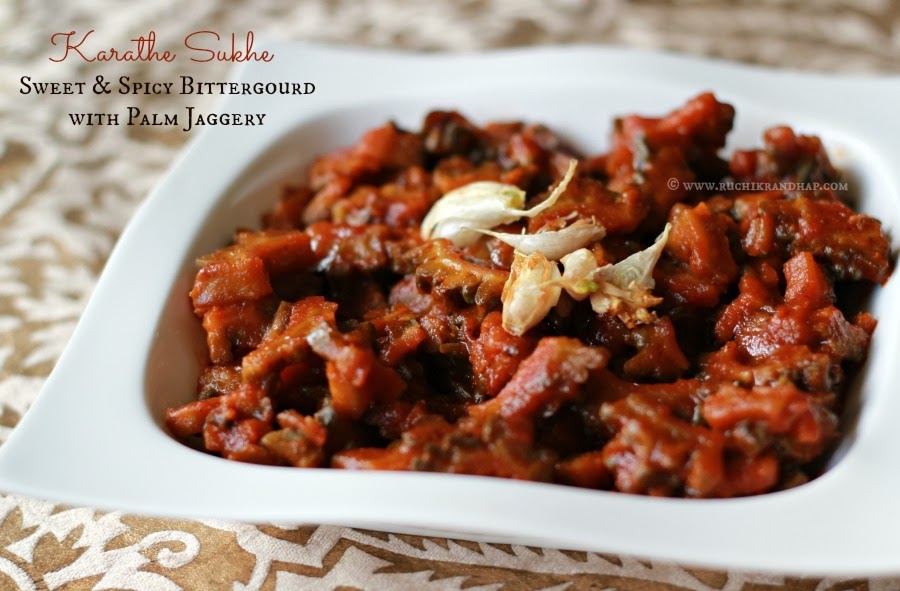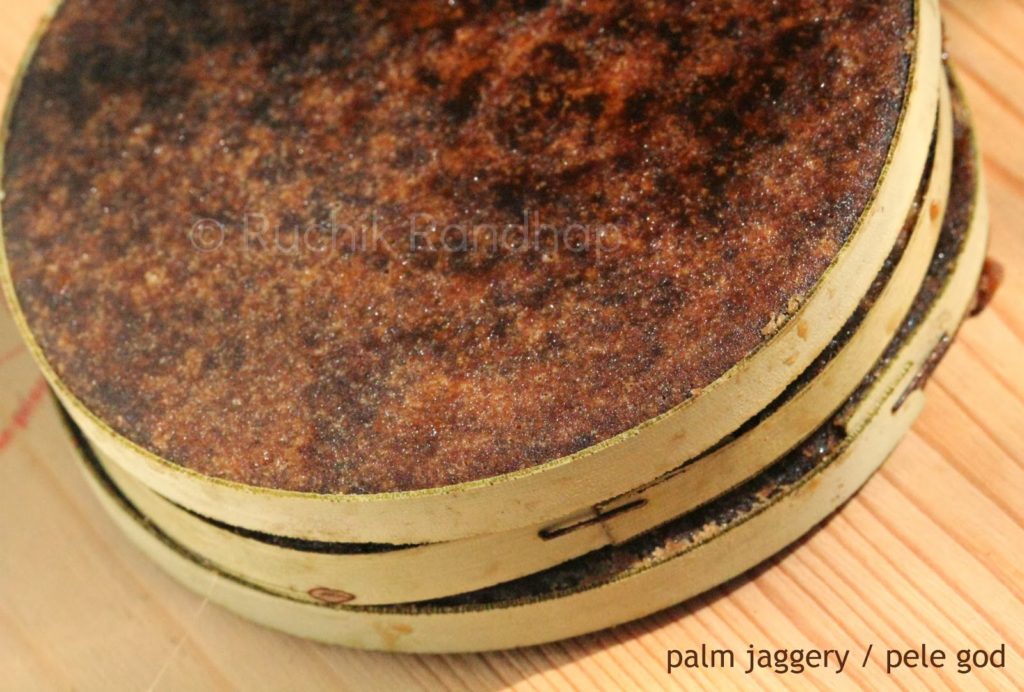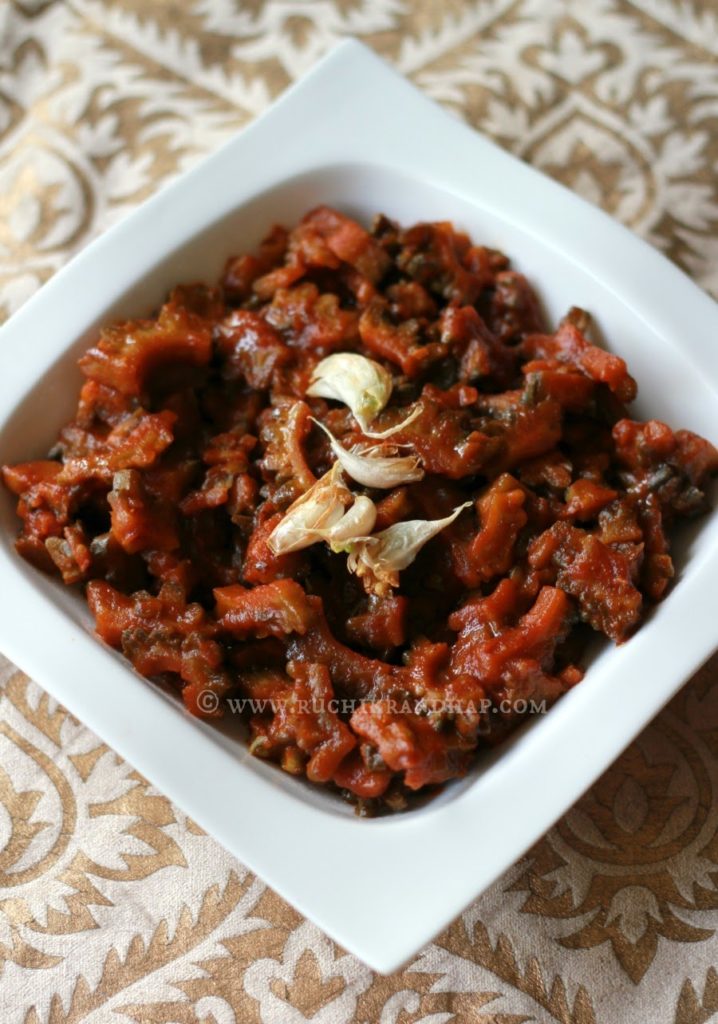 The Lenten season has begun last Wednesday and I have decided to wean myself off blogging for sometime. Plan to spend more meaningful time with my family. Ok, I am not sure how long I will do that and sooner than later I will be back to blogging obsessively. What’s the harm in trying eh?
The Lenten season has begun last Wednesday and I have decided to wean myself off blogging for sometime. Plan to spend more meaningful time with my family. Ok, I am not sure how long I will do that and sooner than later I will be back to blogging obsessively. What’s the harm in trying eh?
Since a lot of people I know are on a vegetarian diet I decided to post this recipe first. It is one of our favourite ways to prepare bittergourd. The first time I tried it from a book, almost 9 years ago, it was an instant hit. I substituted palm jaggery with the regular cane jaggery that the recipe asked for and I think it made all the difference. Not only does palm jaggery impart that rich, deep brown colour to any dish you add it to, the flavour is unmistakably of Mangalorean cuisine.
Palm jaggery is known for its health benefits and is supposed to be more healthy than cane jaggery. A lot of Mangalorean recipes call for the palm jaggery, especially the post natal ones. This recipe is specially for Anitha Sarathy, my ex colleague & close friend who has just had a baby. She totally freaked out on this dish when I prepared it for her a few years ago (much before the blog came into existence). Although I promised her that I would give her the recipe, I forgot all about it. Now is the perfect time to share it. Its a great dish for lovers of bitter gourd and I am sure that after tasting this preparation even non bitter gourd lovers will soon turn into converts 🙂
Karathe Sukhe (Sweet & Spicy Bittergourd with Palm Jaggery)
Prep time: 15 mins | Cook time: 15 mins | Serves 3-4
Ingredients:
- 1/2 kg bittergourd/karela
- 2 hog plums (ambade) or 1 marble size ball of tamarind, soaked and juice extracted
- 50-70 grams palm jaggery/ole bella/pele god (substitute with regular cane jaggery) * see notes
- Salt to taste
For the masala:
- 4-5 long red chillies, spicy variety (deseeded) I used Bedgi chillies * see notes
- 2 kashmiri chillies deseeded
- 7-8 peppercorns
- 1/2 teaspoon cumin
- 1/4 teaspoon mustard
- 1 small-medium sized onion
- 1 marble sized ball of tamarind
For tempering:
- 3-4 small cloves of garlic with skin, crushed
- 2 teaspoons oil or ghee
Method:
1. Wash the bittergourds well, snip the ends and cut them vertically. Scoop out the pith & seeds and slice them into 1 cm pieces. If the bittergourds are large then you can quarter them vertically and then slice them.
2. Optional step: If you prefer eating bittergourd that doesn’t taste too bitter, then transfer the slices into a pan, add enough water to cover them, add salt to taste and boil them for about 3-4 minutes. Discard this water and immediately refresh the pieces with cold water to prevent over cooking. Please note that from a health point of view you should not drain the water as it leads to loss of precious nutrients.
3. Grind all the ingredients mentioned under ‘For the masala’ to a fine paste. Transfer it into heavy based/non stick pan and add the bitter gourd pieces. Add salt to taste if you have skipped Step#2
4. Place the pan over a medium heat, sprinkle water to ensure that the pieces don’t get scorched. Add the powdered jaggery and allow to cook for about 8-9 minutes (cooking time will vary if you have pre boiled the bitter gourd – take care not to overcook them). See notes. When the bitter gourd is cooked, remove from heat.
5. For the tempering, heat the ghee or oil in a small pan and add the garlic cloves and toss them about for a few seconds. Pour this into the pan and cover the lid.
1. Wash the bittergourds well, snip the ends and cut them vertically. Scoop out the pith & seeds and slice them into 1 cm pieces. If the bittergourds are large then you can quarter them vertically and then slice them.
2. Optional step: If you prefer eating bittergourd that doesn’t taste too bitter, then transfer the slices into a pan, add enough water to cover them, add salt to taste and boil them for about 3-4 minutes. Discard this water and immediately refresh the pieces with cold water to prevent over cooking. Please note that from a health point of view you should not drain the water as it leads to loss of precious nutrients.
3. Grind all the ingredients mentioned under ‘For the masala’ to a fine paste. Transfer it into heavy based/non stick pan and add the bitter gourd pieces. Add salt to taste if you have skipped Step#2
4. Place the pan over a medium heat, sprinkle water to ensure that the pieces don’t get scorched. Add the powdered jaggery and allow to cook for about 8-9 minutes (cooking time will vary if you have pre boiled the bitter gourd – take care not to overcook them). See notes. When the bitter gourd is cooked, remove from heat.
5. For the tempering, heat the ghee or oil in a small pan and add the garlic cloves and toss them about for a few seconds. Pour this into the pan and cover the lid.
Notes:
1. This dish tastes best if palm jaggery is used. In Mangalore we get the Palmyra Palm Jaggery which is available in the form of discs. Each disc roughly weighs 50 grams – these are medium sized ones available these days. Earlier I used to bring those that weighed approx 150 grams each, so please use a weighing scale and add the correct amount to the dish. Alternatively you may add as you go and do taste checks to determine the sweetness you prefer.
2. Bedgi/Byadge chillies are long and crinkly and often mistaken for Kashmiri chillies which are less spicy than the Bedgi variety. Bedgi chillies impart a great colour and spice that is so inherent to Mangalorean cuisine. I suggest deseeding chillies so that you can get enough masala base that doesn’t too spicy.
3. Depending on the size of the slices you may need to adjust the cooking time. Adjust the sweetness as desired by adding more jaggery. Add more tamarind juice if you like. The resultant dish should have all the 5 elements – saltiness, spiciness, sweetness, sourness and bitterness to it.
1. This dish tastes best if palm jaggery is used. In Mangalore we get the Palmyra Palm Jaggery which is available in the form of discs. Each disc roughly weighs 50 grams – these are medium sized ones available these days. Earlier I used to bring those that weighed approx 150 grams each, so please use a weighing scale and add the correct amount to the dish. Alternatively you may add as you go and do taste checks to determine the sweetness you prefer.
2. Bedgi/Byadge chillies are long and crinkly and often mistaken for Kashmiri chillies which are less spicy than the Bedgi variety. Bedgi chillies impart a great colour and spice that is so inherent to Mangalorean cuisine. I suggest deseeding chillies so that you can get enough masala base that doesn’t too spicy.
3. Depending on the size of the slices you may need to adjust the cooking time. Adjust the sweetness as desired by adding more jaggery. Add more tamarind juice if you like. The resultant dish should have all the 5 elements – saltiness, spiciness, sweetness, sourness and bitterness to it.


Sounds gr8 recipe..nice
Am in love with the colour of the pickle, soooo irresistible.
Wooooow terrific recipe & wht abt adding sme dry sugata ( prawns )
@ Linda: Thanks so much, yeah, why not!
Thanks Mai, Haji hawn kharathae sukhe kerchaka ashjallaa. Thanks, Jai Hind, Jai Ho Mangalore.
We tried your recipe today and loved the same , It was quite differener
Thanks a lot for your feedback!
Just cooking this one Shireen! I jazzed it up with some canned chikpeas, and left over cashew nuts and some raisins. Will see how this experiment turns out 😉 the base recipe tastes wonderful already! Thanks again!
Hey Sandy!
Glad to hear that! Thanks a ton for the feedback. That karathe sukhe with the chickpeas and cashew nuts sounds yum!
Came out awesome…true manglorean taste what my mom used to make… my husband who does not like bittergourd loved this recepie
Happy to hear that you enjoyed it so much Clara! Thanks for the feedback!